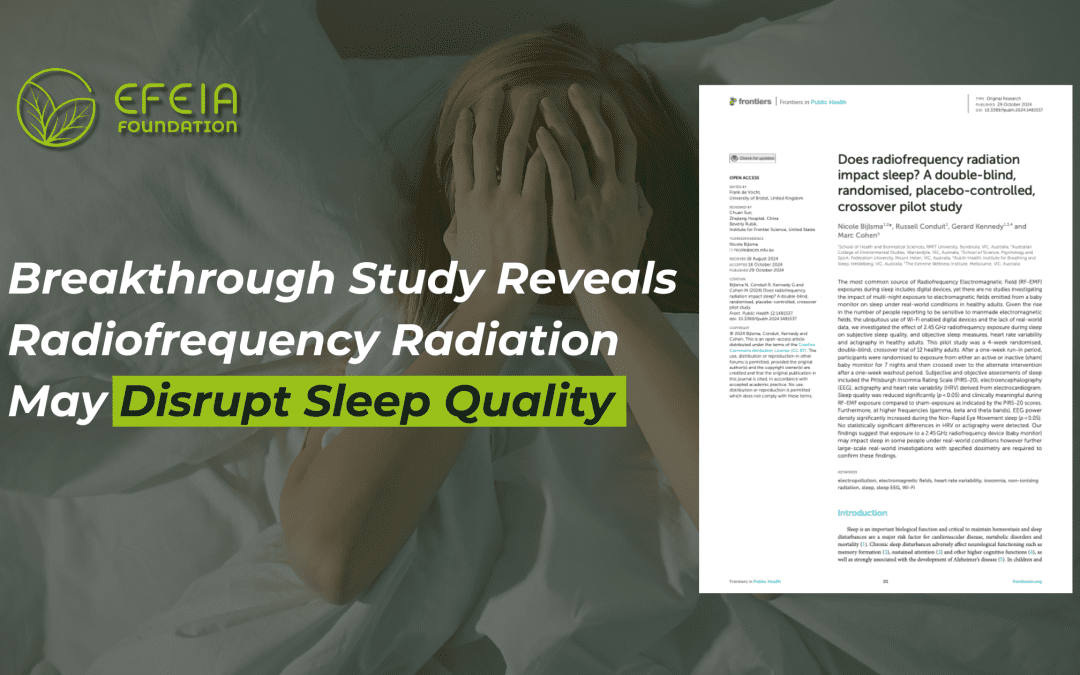In a groundbreaking scientific advance, researchers have delivered new evidence that common household wireless devices may be disrupting our sleep. The landmark study titled “Does radiofrequency radiation impact sleep? A double-blind, randomised, placebo-controlled, crossover pilot study,” published in October 2024 in Frontiers in Public Health, represents a major breakthrough in understanding the potential health effects of our wireless environment.
Led by Nicole Bijlsma from RMIT University and the Australian College of Environmental Studies, alongside co-researchers Russell Conduit, Gerard Kennedy, and Marc Cohen, this pioneering research provides the first real-world evidence that exposure to radiofrequency electromagnetic fields (RF-EMF) from everyday devices may significantly impact sleep quality and brain activity during rest.
A Methodological Breakthrough in RF-EMF Research
What makes this study revolutionary is its unprecedented approach to investigating RF-EMF effects on sleep. Previous research has been primarily confined to laboratory settings with artificial exposures and single-night measurements—conditions that poorly reflect our everyday reality. The Bijlsma study addresses this limitation through a sophisticated four-week crossover trial with 12 healthy adults in their own homes.
“Given the rise in the number of people reporting to be sensitive to manmade electromagnetic fields, the ubiquitous use of Wi-Fi enabled digital devices and the lack of real-world data,” the researchers explain, they sought to address a critical gap in scientific understanding.
The study protocol included:
- One-week baseline period for initial measurements
- Random assignment to either active or inactive (sham) baby monitor for seven consecutive nights
- One-week washout period to eliminate carryover effects
- Crossover to the alternate condition for another seven nights
The methodological strengths were numerous:
- Double-blind design: Neither the participants nor the researchers knew which condition was active
- Real-world setting: Testing in participants’ own bedrooms rather than artificial laboratory environments
- Multi-night exposure: Seven consecutive nights better reflects real-life conditions
- Comprehensive measurements: Both subjective assessments (PIRS-20 questionnaire) and objective measurements (EEG, actigraphy, heart rate variability)
The Baby Monitor as a Test Device
The researchers used a commercially available Uniden baby monitor operating at 2.45 GHz—the same frequency used by many Wi-Fi devices. The monitor and camera units were placed within two meters of participants’ beds. For the “sham” condition, the wireless modules were removed from the devices, though all units appeared identical with their display screens and lights disconnected.
Importantly, the radiation levels (2.2-7 mW/m²) were well below international safety guidelines of 10 W/m² for frequencies above 2 GHz. This means the study examined effects from radiation levels considered “safe” by current standards.
Detailed Findings: Significant Effects on Sleep Quality and Brain Activity
The study produced compelling evidence of RF-EMF’s impact on human sleep through both subjective and objective measurements:
Subjective Sleep Quality
The Pittsburgh Insomnia Rating Scale (PIRS-20) scores revealed statistically significant and clinically meaningful reductions in sleep quality during RF-EMF exposure compared to sham exposure (p < 0.05). The mean score increased from 9.63 during sham exposure to 14.64 during active exposure—an increase large enough to be considered clinically important (Cohen’s d = 0.75). Most notably, three participants (27.3%) crossed the threshold score of 20, indicating risk of clinical insomnia during the RF-EMF exposure week, despite having no such risk during other study phases.
Objective Brain Activity Changes
Using single-channel electroencephalography (EEG), researchers documented statistically significant increases in brain wave activity during Non-Rapid Eye Movement (NREM) sleep in multiple frequency bands:
- Theta band (3-8Hz): Significant increase (p = 0.04) with large effect size (d = 0.87)
- Beta band (13-30Hz): Significant increase (p = 0.03) with large effect size (d = 0.93)
- Gamma band (30-70Hz): Significant increase (p = 0.02) with very large effect size (d = 1.04)
- Alpha band (8-13Hz): Increase with medium-large effect size (d = 0.63), though not reaching statistical significance (p = 0.16)
These alterations in brain wave patterns occurred specifically during NREM sleep but not during Rapid Eye Movement (REM) sleep, suggesting a targeted effect on certain sleep phases.
Additional Observations
Interestingly, other objective measurements including heart rate variability (HRV), actigraphy, sleep efficiency, total sleep time, and wake time after sleep onset showed no statistically significant differences between conditions. The double-blinding was successful, as only 44% of participants correctly identified which week had the active monitor—effectively chance level.
Implications for Public Health
The findings raise important questions about our ubiquitous use of wireless devices, particularly in sleeping areas. Some key takeaways:
- Individual sensitivity: The study suggests some people may be more sensitive to RF-EMF exposure, with older women potentially showing greater susceptibility.
- Precautionary approach: Given the findings, it may be prudent to keep wireless devices away from bedrooms, especially for people with sleep problems.
- Need for larger studies: While this was a pilot study with only 12 participants, the effect sizes were large enough to suggest meaningful impacts that warrant further investigation.
Study Limitations
The researchers acknowledge several limitations:
- Small sample size: With only 12 participants, the study may have been underpowered to detect some effects.
- Variable exposure: Although efforts were made to standardize the placement of devices, real-world settings introduce some variability in exposure levels.
- Single-channel EEG: The portable EEG system used didn’t provide the same precision as multi-electrode lab-based systems.
What This Means for You
While more research is needed, this study suggests some practical considerations:
- Distance matters: Consider keeping wireless devices away from your bed—or ideally, out of the bedroom entirely.
- Nighttime settings: Turn off Wi-Fi routers and other wireless devices at night when possible.
- Individual differences: If you experience sleep problems, be aware that sensitivity to RF-EMF may vary between individuals.
- Baby monitors: Parents using wireless baby monitors might consider alternatives or ensure the monitor is placed at a distance from both parent and child.
The Bigger Picture
This study adds to a growing body of evidence suggesting that exposure to RF-EMF may affect brain activity and sleep quality. While the mechanisms aren’t fully understood, potential explanations include direct effects of pulse-modulated RF-EMF on brain activity, melatonin suppression from blue light exposure, or device-induced arousal.
As the authors note, “Our preliminary findings demonstrate that radiofrequency devices induce statistically significant changes in the EEG during Non-Rapid Eye Movement (NREM) sleep and suggest these devices may have a clinically important adverse effect on sleep in some people in real-world scenarios.”
With billions of wireless devices in use worldwide and sleep disorders affecting nearly 40% of Australians, understanding these potential connections is increasingly important for public health.
The researchers conclude with a precautionary note: “Until further studies verify or provide evidence contrary to these findings, caution is advised when using RF-EMF devices in bedrooms.”
Further Research Needed
The study authors call for larger-scale investigations that account for individual factors such as gender, age, genetic variants, and exposure history. Future studies should also include more detailed exposure dosimetry and consider signal features such as modulation, field strength, and pulsing, which may influence biological effects.
As we continue to surround ourselves with wireless technology, understanding its potential impacts on our health—particularly on something as essential as sleep—remains an important area for ongoing research.

